THE GENTRIFICATION OF SARATOGA PARK (1896)
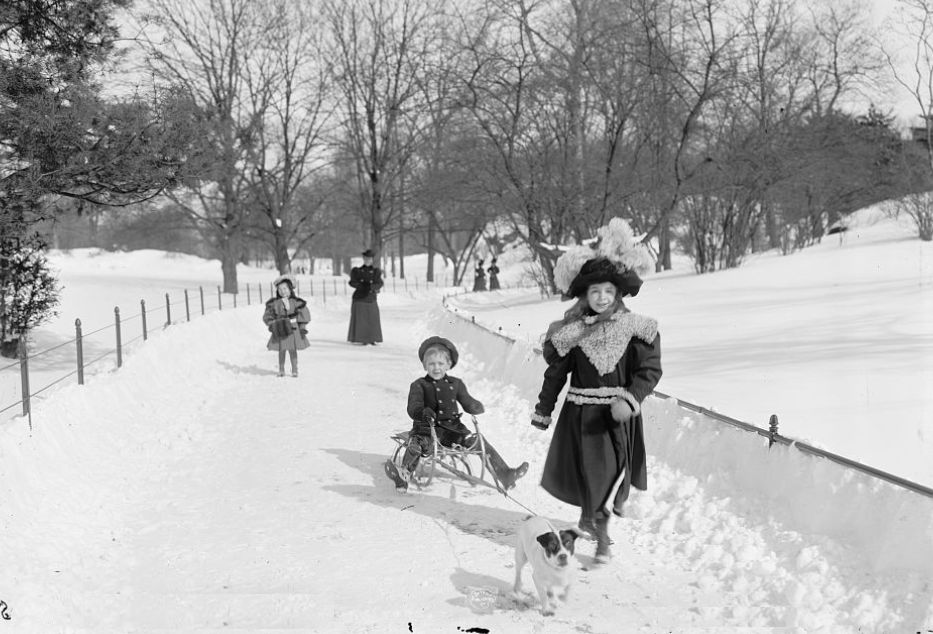
Brownstone Detectives investigates the history of our clients’ homes.
The story you are about to read was composed from research conducted in the course of one of those investigations.
Do you know the history of YOUR house?
********************************************************************************************************************************
Around the mid-1890s, the public in the Eastern District of Brooklyn – in what would come to be known as the Stuyvesant Heights section of Bedford-Stuyvesant – began clamoring for a space for a local park.
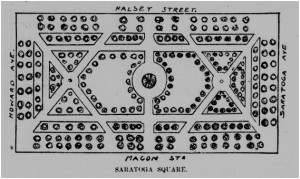
There were three things driving this support: 1) the extension of the Brooklyn street grid system, along with 2) failing attempts by local governments in keeping pace with the growing population in the 25th Ward, and partly due to 3) the success and popularity of Central Park in Manhattan and Prospect Park in Brooklyn.
As a result, the City’s aldermen, sensing the growing aspiration for “breathing space” in the locality, went looking around for an adequate stretch of land to acquire for a park – something that would suit the local residents.
After a thorough exploration within the ward, the City’s elders settled upon a square little more than 3 acres in size, bounded by Halsey and Macon streets, and Howard and Saratoga avenues. Other than the fact that it was in a very desirable location, it was really the only choice they had – it was the single available piece of undeveloped land in the district of its size.
O! And then there was the price…
JAMES CLINTON BROWER ENTERS THE SCENE
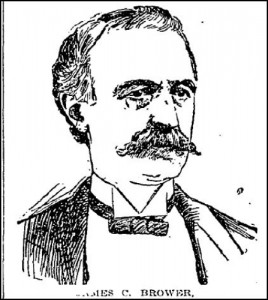
This singular block of land, in use for the past few years mainly as an unofficial home for traveling circuses and assorted sports, was owned by a successful businessman by the name of James Clinton Brower.
Born in 1834 in Dutchess County of German heritage, Browner moved to Brooklyn in 1861. Around that time, he got into the hardware business, opening his first store on Broadway and quickly amassing a fortune.
Taking up occupancy with his family first at the corner of Cumberland Street and Myrtle Avenue, he later moved to Ralph Avenue (where it meets Broadway) in the 25th Ward, after opening his first hardware store.
Fortunately for the city – and for inhabitants of the area today – Brower was a civic-minded resident. As it turned out, when the City approached him about selling this land for a public park, he was happy to offer the “circus grounds” to the City – and for a fair price, too.
In 1895, he parted with the future Saratoga Square for $121,975.00. That amount, divided into the number of lots that could potentially have been developed on the land, came approximately to $1285 a lot.
Not bad for an entire block in 1895.
THE TWENTY-FIFTH WARD GETS SOME LEBENSRAUM
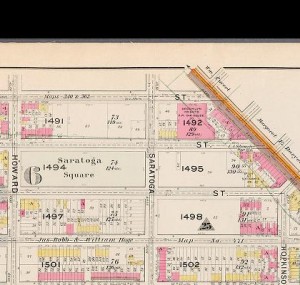
Hyde & Co. 1898-99, Vol. 1
In 1896, the city laid out and began to develop Saratoga Square. Regardless of the back and forth political salvoes that noted for instance that the city’s buying of parks had lately been undertaken to the detriment of better schools in the borough, Saratoga Square opened in 1897 to great fanfare and popular acclaim.
In 1897, the park was further developed. From news reports, it seemed that the paths laid out were originally covered with coal ashes as well as “crushed blue limestone and blue limestone screenings.” Flowers were planted in the middle of the park around a 60-foot tall flagstaff, and the entire park was surrounded by an iron fence.
The Department of Parks further noted in its Annual Report, that 79 evergreens were planted, along with 1,973 shrubs; 1,075 pounds of grass seed was sown.
Additionally, the report noted, “two electric lights were provided for this park,” and “two bubble fountains were erected.”
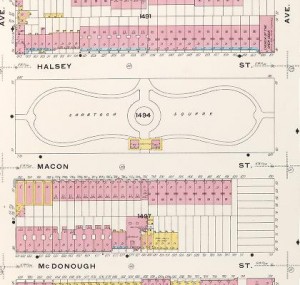
For security purposes, although it could hardly be guessed that such would be necessary, the Police Department provided two patrolmen to ensure 24-hour duty in the park. In all of 1897, though, only one arrest was affected.
In 1900, the city began to plan for a shelter house and lavatory for women and children, for which the city, within the next several years put out bids, and which eventually, in 1904, was built at the Macon Street entrance of the park.
That year, the walks surrounding the park, that had been, in 1897, “graded and and covered with steam cinders to a depth of 5 to 6 inches” and “topped with limestone screenings,” were finally finished and laid with cement.
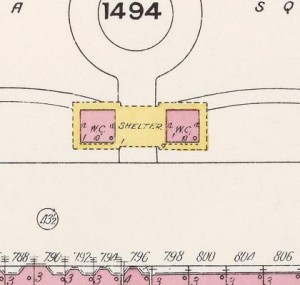
For about 6-7 years, the Park earned a spotless reputation as a choice “breathing-space” for inhabitants of the 25th Ward. It was a gem surrounded by upper middle class comfort, populated by children playing freely and adults enjoying the large open space situated in the middle of their neighborhood.
This period within the park’s history was relatively calm and uneventful. People used the park primarily for the reasons it was built – as a pleasure space for the locals to forget the cares of the day and cool off in the blistering summer months.
But trouble was brewing just beneath the surface. The sons of upstanding families soon began to gather in the park and make it their fun to cause trouble….
See Pt. II, “The King of Skats in Saratoga Park,” tomorrow.
———————————————————————————————————————–
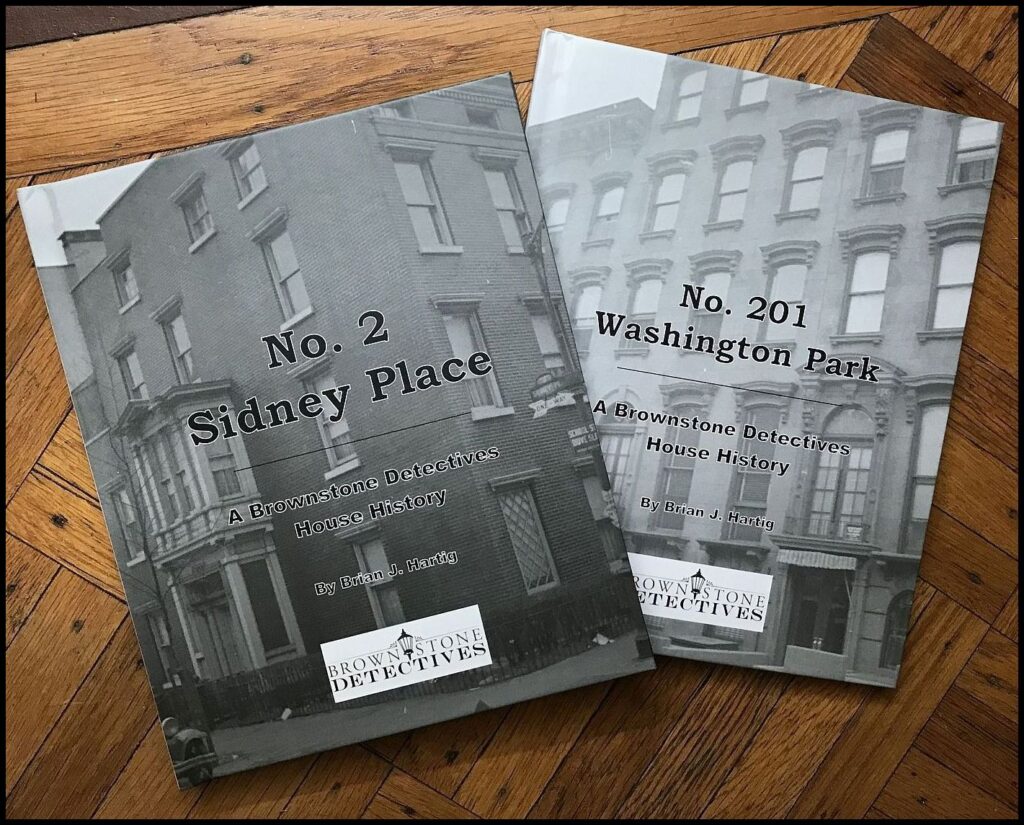 Brownstone Detectives is an historic property research agency. Our mission is to document and save the histories of our clients’ homes. From our research, we produce our celebrated House History Books and House History Reports. Contact us today to begin discovering the history of your home.
Brownstone Detectives is an historic property research agency. Our mission is to document and save the histories of our clients’ homes. From our research, we produce our celebrated House History Books and House History Reports. Contact us today to begin discovering the history of your home.